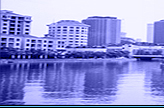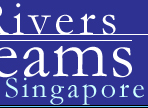



|
Modification of catchment areas The term “concrete jungle” has
been commonly used to describe the transformation of Singapore
landscape into highly impervious environment. As a result, there
are interventions in the hydrological cycle shown in Figure 2.
In urban hydrological cycle, subsurface flow is virtually nonexistent,
increasing the rate of surface flow. There is a decrease in basin
storage due to decline in infiltration from impervious surfaces.
Similarly, interception loss is also affected in the process as
native vegetation is removed or replaced by foreign species. It
has been found that different tree species could result in significant
differences in interception loss through their tree morphology
(Lee 2000). Under such circumstances, it is no surprise that urban
hydrograph will peak 2 – 4 times higher than undeveloped
areas, depending on amount of impervious surfaces, drainage facilities
and channel modifications (Lazaro, 1990). |
||||
 |
|||||
| .:: Figure 5, Schematic
hydrographs showing the effect of urbanization on lag time and peak
discharge. Points CMP and CMR are centers of mass of rainfall and
runoff, respectively (after Strahler and Strahler, 1992) ::. |
|||||
| Singapore also attempts to reserve its natural area through proper land use plans. Over the past few decades, many revisions have been made to the land use plans. New plans have also been conceptualized and implemented. The most recent plans include the 1998 Master Plan, Concept Plan 2001, the draft Master Plan 2003, the Parks and Waterbodies Plan. As part of the land use plans adopted by the government authorities, several nature parks and reserves have been established. Some of these reserves, for example, the Central Catchment Reserve, are functionally important as water catchment areas in water-scarce Singapore. Besides functioning as recreational spaces, these parks and reserves serve to conserve the remaining rainforest and mangrove ecosystems of Singapore. An ecosystem is a group of organisms and the environment in which the organisms interact. Primary rainforest, the original vegetation cover of most of the island, is now restricted to the Bukit Timah Nature Reserve, which was one of the first forest reserves established in 1883 by the colonial government. Undisturbed rainforest has a distinct and complex three-dimensional structure which can be observed to varying extents in the remnants found in Singapore, particularly the core areas of Bukit Timah. The 81-hectare Bukit Timah Nature Reserve supports more than 850 species of vascular plants and 160 species of animals. | |||||
| Developed by Centre For Instructional Technology, NUS © 2003 | |||||
![]]] CASE STUDY [[[](images/but_csstd_up.jpg)